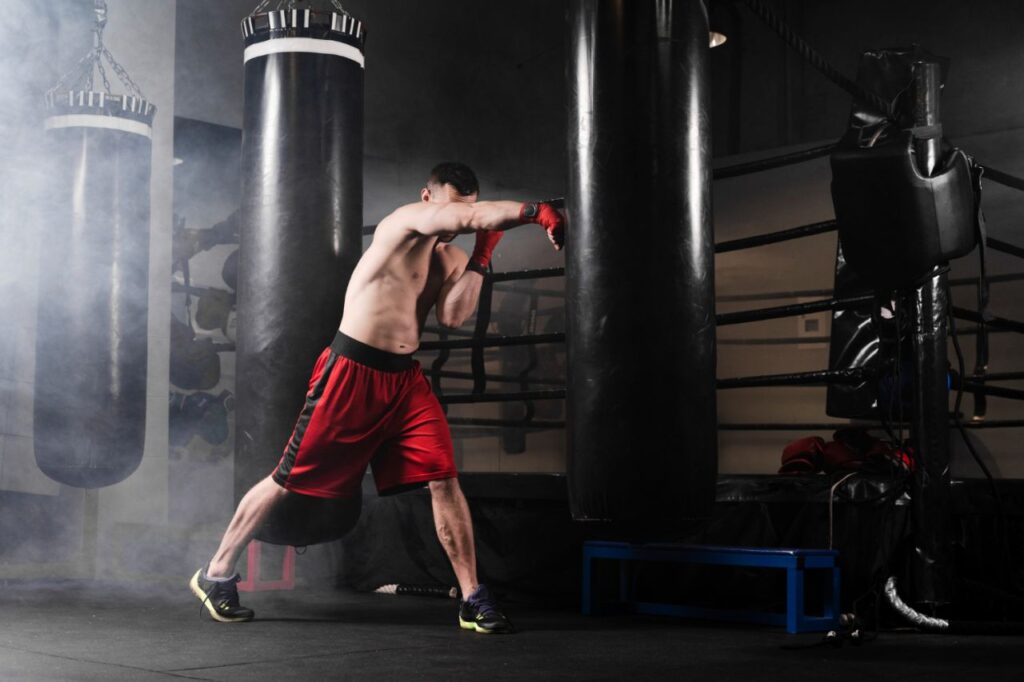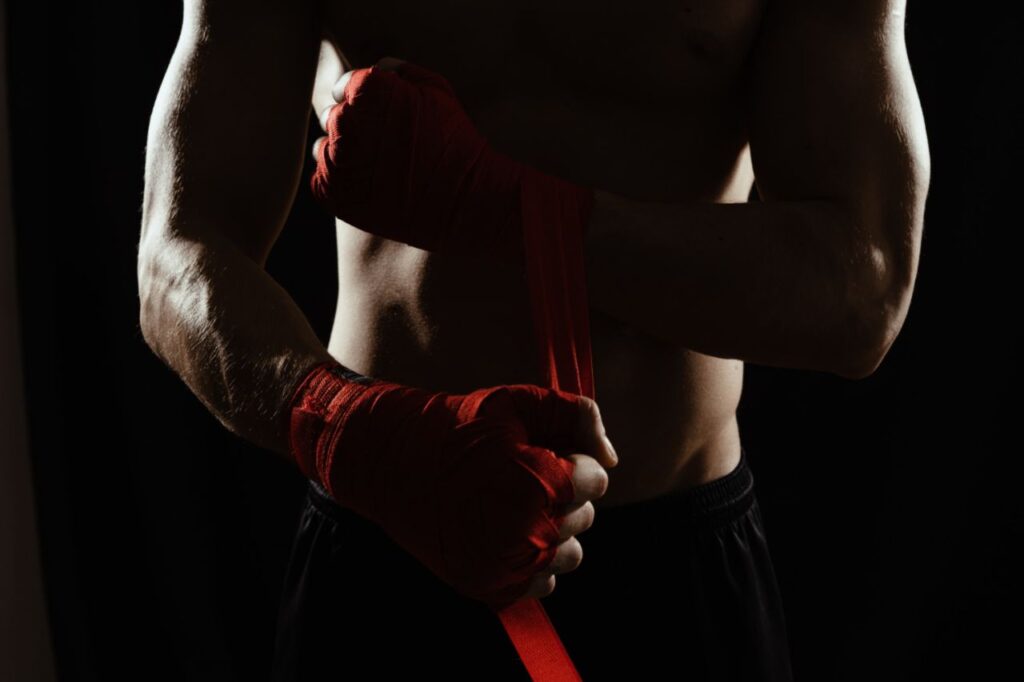There's no doubt that a heavy bag workout is an intense cardio session, but is it the best way to get in shape?
That depends on your goals. If you're looking to improve strength and endurance, then a heavy bag workout is definitely for you.
But if you're looking to lose weight or tone up, there are other exercises that might be better suited for your needs. experimenting with different types of workouts will help you find what works best for you.
So don't be afraid to try something new – a heavy bag workout could be just what you need!
The heavy bag, also known as a punching bag, is a tremendous piece of training equipment. This tried and tested boxing tool has shaped many champions in the ring, and continues to be an important part of any boxing studio.
Formerly reserved for boxers or MMA fighters, this classic and effective piece of equipment has crept into mainstream fitness centers, and proves to offer a high intensity boxing workout for those who take advantage of it.
So, what is a heavy bag anyway, and why is it so important?
First, A Little History Lesson
The exciting sport of boxing dates all the way back to the ancient Olympic Games. Boxers were trained essentially as if they were soldiers preparing for war. There was very little sophistication in the sport, and fighters boxed bare-handed, which often led to the death of an opponent.
The sport was brutal. In fact, one of the earliest boxers named Eurydamas was known for his fierceness in the ring, and was reported to have swallowed his own teeth during a match rather than admit that he had been severely injured - yikes!
By the beginning of the first century A.D., however, boxing was forbidden, and wouldn’t be seen again in the world of sports until the 18th century in Great Britain.
James Figg was the first recorded English boxing champ, fighting in the early part of the 1700s. Jack Broughton was the next champion following Figg, and was considered a master of blocking and hitting on the retreat.
In 1743, Broughton changed the sport forever and created a very much needed boxing code of conduct called the London Prize ring rules. In addition, Broughton also devised special gloves called "mufflers," so fighters wouldn’t so easily injure their hands.
As time went on, boxing was further refined by the establishment of the Queensberry Rules, which were created under the sponsorship of another boxing patron, Josh Sholto Douglas, the eighth Marquess of Queensberry. Some of the rules are:
- No wrestling or hugging allowed.
- Gloves are required and are to be fair-sized boxing gloves of the best quality.
- No shoes or boots with springs allowed.
- A man on one knee is considered down.
- No hits below the belt, to the back of the head, to the neck and to the kidneys.
Boxing FAQs
Is A Throat Punch Illegal In Boxing?
A fighter may not gouge their fingers or thumb into their opponent's neck or trachea in an attempt to submit their opponent. If during stand up action of a fight a punch is thrown and the punch lands in the throat area of the fighter, this shall be viewed as a clean and legal blow.
What Is The Right Age To Start Boxing?
The most Ideal Age to Start Boxing? – 8 Years Of Age. While medical experts highly recommend boxing workouts for children seven years and younger, a lot of them recognize that the ideal age to start boxing is somewhere around eight years old. This is when a child should begin to enroll in serious training sessions.
Can I Teach Myself Boxing?
So, can boxing be self-taught? Boxing can be self-taught but it's not the quickest and most effective way to become better at the sport because you aren't able to tap into the knowledge of a boxing coach who would be able to help you one to one.
What Makes Boxing So Difficult?
It's not just physical exhaustion, but also the mental concentration required in boxing. It's the willingness to confront not only your opponent, but also your own fear. That reason, fear, as ESPN indirectly pointed out, is the reason more than any other that boxing is the most difficult sport.
Is Learning Boxing Hard?
Boxing is an exciting sport to learn, and beginners often want to see progress quickly. But another common mistake is rushing development. You must understand that even the most skilled and talented of professionals are still striving to improve their techniques and sharpen every small detail in training.
Everything There Is To Know About The Heavy Bag
To this day, it is uncertain as to when punching bag workouts became a staple of the boxer’s training regiment, but the first heavy bag patent was registered to Simon D. Kehoe in 1872. Since then, the heavy bag has been quintessential to the world of boxing, and is one of the most effective tools used to train - but what exactly is it?
At first glance, the heavy bag may look a little intimidating to some. It is a familiar fixture in classic films like Rocky where we see our protagonists using the bag to unload power punches in impressive punch combinations.

In its essence, a heavy bag is a sturdy bag designed to be punched repeatedly. They are usually cylindrical and filled with various materials like sand or sawdust. The more material you have, the firmer and heavier your bag will be.
While the most obvious benefit of the heavy bag is a chance to practice your right hook and jab-cross, it carries a variety of other benefits as well!
Heavy bag workouts can help to improve technique, provide strength training for power, build better balance and coordination, and even reduce stress.
Improves Boxing Technique
One of the most apparent benefits of hitting the heavy bag is that it improves your boxing technique. Many people are under the impression that boxing is all about who can best throw punches, but this couldn’t be further from the truth.
Sure, punching power is important, but boxing is also about executing each movement with proper form and precision.
Throwing some straight punches while maintaining good form will not only improve your punches overall, but your body movement and overall performance as well.
In fact, unlike shadowboxing, a heavy bag workout allows you to experience the force of impact with each and every punch you throw, making it an ideal way to improve one’s boxing technique.
Improves Strength And Power
Heavy bag workouts are great for strength training and enhancing power because it focuses on building as many muscles as possible.
The muscles in your upper body like your arms, chest, back, and shoulders, as well as your lower body's legs and even your core are all engaged during a heavy bag training session, making it an extremely effective full-body workout.
With a heavy bag, you can practice punching and kicking with the greatest possible force, which can improve your strength and power over time.
Builds Your Endurance
If you have ever given a heavy bag workout 100% maximum effort, then you know firsthand it is no easy feat. This extra challenge to give it your all will push you beyond the boundaries of your cardio comfort zone, which will build up your endurance as you train.
The more you push past your limits, the more you will be able to endure. Whether you are in the ring sparring with a partner or simply taking the stairs instead of the elevator, you will notice the impacts on your endurance from heavy bag training over time.
Improved Coordination, Balance, And Stability
If you have ever watched someone during a heavy bag workout, you may have noticed that they are never just standing still. When training, boxers move around the bag and incorporate footwork into their workout routines.
Footwork drills like circling the bag while throwing a left hook will help to improve both your balance and coordination.
Staying fast on your toes and making the effort to transfer your weight from one foot to the other while also moving around is an excellent way to build stability and balance.
In addition, it’s not just your body that is working during a heavy bag workout.
While throwing punches and delivering kicks, the bag comes back suddenly and unexpectedly. For this reason, it is important to remain attentive and alert, which improves sensory-motor coordination and your reaction time.
Reduces Stress
Everyone experiences a little bit of stress from time to time ,and if yoga isn’t your thing, boxing is a great alternative! Heavy bag workouts provide similar benefits to martial arts in that they can improve your mood, help you release anger, and even relieve stress. In fact, it is a form of both physiological and mental stress relief.
Physically, exercise and increased heart rate promotes the production of neurohormones like vasopressin and norepinephrine, which is associated with heightened cognitive function along with improved mood.
Mentally, hitting the heavy bag acts as a symbolic release of stress when you imagine the bag as a representation of everything and anything that causes you trouble or anxiety.
Believe it or not, chronic stress can take a huge toll on your body and can even lead to serious health problems such as:
- Heart disease
- High blood pressure
- Diabetes
- Anxiety disorder
- Depression
- Other illnesses
High amounts of the hormone cortisol are released in the body during times of stress. This hormone increases appetite and can affect your sleep, cognition, and energy levels. In today’s busy world full of chaos, it is imperative to have healthy methods of releasing your worries, and heavy bag workouts can do just that!
Four Heavy Bag Training Tips
Wrap Your Hands
It goes without saying that wrapping your hands properly before sparring with a partner is crucial. However, what many don’t realize is that wrapping your hands during a heavy bag workout is as equally as important.
Give yourself sufficient time before you start training to put on your hand wraps and secure your gloves. Punching bags are heavy, and if your hands and wrists are not properly secure, you will be at risk for injury.
Warm Up First
Like with any sport or exercise, it is important to warm up before you start. Begin with a 2 to 3 minute round of light punching while circling the bag. This will help to get your muscles ready for those punches, and help you to hone in on your form as well.
Breathe Correctly
Proper breathing is imperative to your heavy bag workout. Inhaling during a resting motion and exhaling during exertion will allow oxygen to flow through your body to fuel your working and tiring muscles.
Train With Proper Technique
Although many heavy bag workouts are focused on speed and power, it’s important to remember that proper technique comes first. Power and speed tend to improve with practice and time, but technique is something that needs to be focused on from the start.
If you don’t have proper technique, you will be at a much greater risk for injury, and might find that staying balanced is much more of a challenge.
Benefits Of Heavy-Bag Workouts
Heavy-bag workouts have numerous health benefits:
- enhance aerobic fitness, core stability, coordination, power, stamina, and endurance
- improve upper-body strength and strengthen bones and ligaments
- enhance boxing technique
- increase self-defense skills
- reduce anxiety and stress
- improve self-esteem, confidence, and body image
- help with weight loss and tone
Regardless of the exercise workout, it’s extremely important to hydrate and get adequate sleep.
Boxing Workouts For Beginners
For beginners, it’s best to take things at your own pace and add to your regular routine gradually. You can start out with basic punches and then start combining them and intensifying your workout.
Basic boxing punches include jabs, crosses, left and right hooks, and left and right uppercuts. You can combine these punches to hone in on different areas of your body or to improve specific boxing techniques. For example:
- jab–cross
- jab–hook–cross
- cross–hook–cross
- jab–cross–hook–cross
- jab–cross–jab–cross–hook–hook
Below is a simple workout routine that you can follow to start off with:
Warmup
- 10 minutes jumping rope
- 20 squats
- 20 push-ups
- 40 crunches
Shadowboxing (Three-Minute Rounds)
- basic jab, cross, and hook punches
- rest for 30 seconds
- repeat four times
For beginners, try to stick to three-minute rounds and then gradually increase to five-minute rounds as you gain strength. Give yourself a minute’s rest between each round.
Pace yourself and keep your movements going with punching the bag, even if you’re just touching it at a low speed.
Finisher
- 50 push-ups
- 50 squats
- 100 sit-ups
- Rest as little as possible
Best Boxing Workouts

The following are some great boxing workouts:
Sparring
Sparring is when you punch an actual opponent without intending to hurt them. No other training better mimics fighting conditions than sparring. Apart from the thrill of exchanging punches, sparring is an excellent boxing workout.
It is actually much harder than the training itself. Every muscle in your body is engaged with each jump, twist, and contortion of your body to counter your opponent’s moves. Your arms get a good workout with each swing.
Your legs wear out more quickly because you keep losing your balance.
Your mind is also fully engaged because you have to be simultaneously anticipating your opponent’s next move while strategizing your next countermove or strike. Your breathing pattern is also different than in training and heightened because you have a mouthpiece.
Mitts
Mitts are one of the best boxing drills for learning a new technique. Mitts work on your timing and precision under circumstances that resemble a real fight. You start with a moving target that punches back at you.
Try not to throw full force into every shot, but work on the precision of each swing, your timing, breathing pattern, coordination, and reflexes. Control yourself and try not to wear yourself out too quickly.
Shadowboxing
Shadowboxing is circling an invisible opponent while boxing at them. Shadowboxing in front of a mirror allows you to see your body and notice all the changes in your movements.
From a physical perspective, it enhances your form, speed, and balance. You can practice whatever you’d like at full speed while moving around. The only things you need to shadowbox are a place to train and free time.
Double-End Bag
The double-end bag is an exercise tool that is somewhere between a heavy bag and a speed bag.
The double-end bag possesses a far greater challenge to strike and develops your higher-level skills, mostly timing and accuracy.
The double-end bag is amazing for improving your hand speed and arm conditioning. If your speed isn’t fast enough to strike the double-end bag, you may not be fast enough to hit an opponent.
We recommend that you wear 12 to 16 ounces gloves for the double-end bag.
Jump Rope
The jump rope trains you mentally and helps you increase your muscle efficiency while enhancing your muscle conditioning. The jump rope mainly teaches body conditioning and relaxation.
Beginners usually struggle between constantly using their muscles and not knowing how to relax. However, if you know how to train yourself to relax, you can jump rope for extended periods and not lose too much energy.
Jumping rope develops mental relaxation and requires a minimum level of awareness.
Physically, it works out your arms, shoulders, back, and legs. You develop better and more relaxed footwork. To take good care of your body, make sure you know what to do after a workout and how to properly cool down and hydrate.
Does Punching A Punching Bag Make You Hit Harder?
There are many reasons why you should start training on a punching bag, and increasing punch power is one of them. The resistance caused by punching a heavy bag helps build muscle, which will ultimately help you hit harder.
Here are three (3) punching bag workout benefits:
More Effective Workout
By providing resistance, the heavy bag not only helps build muscle, but it also makes your whole body work harder. A punching bag cardio workout is one of the best cardio workouts you can do – and it’s fun so you won’t feel like it’s “work” at all.
Improves Accuracy
While shadowboxing will help you practice form, a heavy bag workout will help you improve accuracy. Repeating boxing punch combinations on a punching bag while aiming for the same target helps you develop muscle memory and consistency in every strike.
Increases Coordination
Aiming at a target and encountering resistance will increase your balance and coordination. A powerful punch to a heavy bag will alter your balance, causing you to become more aware of your center of gravity.
Conclusion
A heavy bag can be a great workout, but it won’t make you hit harder. In fact, the only way to improve your punching power is through practice and proper technique.
If you’re looking for a challenging workout that will help you build strength and endurance, a heavy bag is definitely worth considering. Just make sure to use proper form and stay safe while training!
- Find a gym. Boxing gyms aren't typically found in the yellow pages, but there are resources on the internet that can lead you in the right direction. ...
- Be sure the gym is within striking distance. ...
- Be open-minded. ...
- Choose your coach carefully. ...
- Do judge the gym by its cover.
So, can boxing be self-taught? Boxing can be self-taught but it's not the quickest and most effective way to become better at the sport because you aren't able to tap into the knowledge of a boxing coach who would be able to help you one to one.
Best Age to Start
Specialists in sports medicine believe that boxing classes are better to start from 9-10 years. Starting too early could result in putting the student off, as boxing is hard work and not always as fun as team sports, such as football or rugby.

